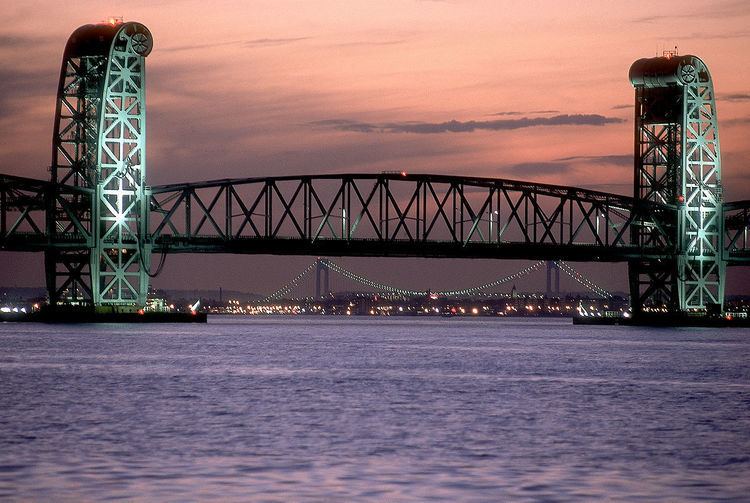Total length 4,022 feet (1,225.9 m) Opened 3 July 1937 | Construction started 1936 Phone +1 212-878-7000 | |
 | ||
Address Marine Pkwy Bridge, Queens, NY 10035, USA Similar Cross Bay Veterans Memorial, Throgs Neck Bridge, Bronx–Whitestone Bridge, Henry Hudson Bridge, Brooklyn–Battery Tunnel | ||
The Marine Parkway–Gil Hodges Memorial Bridge (originally and often referred to as the Marine Parkway Bridge) is a vertical-lift bridge in New York City, New York, that crosses Rockaway Inlet and connects the Rockaway Peninsula in Queens, with Flatbush Avenue to Floyd Bennett Field, Belt Parkway, and the Marine Park neighborhood in Brooklyn. Opened on July 3, 1937, it carries four motor traffic lanes, and a footpath on the western edge. The center span is raised and lowered 100 times a year to allow vessels to pass beneath the roadway; it is 540 feet (160 m) long and is only 55 feet (17 m) above the water but can be lifted to a height of 150 feet above the water. Cyclepaths along both sides of the Parkway connect northward to Brooklyn. The operation of this bridge includes the maintenance of the Marine Parkway from the toll plaza to Jacob Riis Park. Though a city-owned and operated bridge, it connects two parts of Gateway National Recreation Area, a unit of the National Park System: Floyd Bennett Field and Jacob Riis Park. The bridge is designated as New York State Route 901B, an unsigned reference route.
Contents
The bridge is owned by the City of New York and operated by the MTA Bridges and Tunnels, an affiliate agency of the Metropolitan Transportation Authority.
With its distinctive twin towers (which house the vertical-lift machinery), the bridge has become an iconic landmark and symbol of the Rockaways.
Tolls
Starting on March 22, 2015, the cash tolls $4.00 per car or $3.25 per motorcycle. E‑ZPass users with transponders issued by the New York E‑ZPass Customer Service Center pay $2.08 per car or $1.73 per motorcycle.
Open-road cashless tolling will begin in spring 2017. The tollbooths will be gradually dismantled, and drivers will no longer be able to pay cash at the bridge. Instead, there will be cameras mounted onto new overhead gantries near where the booths are currently located. Drivers without E-ZPass will have a picture of their license plate taken, and the toll will be mailed to them. For E-ZPass users, sensors will detect their transponders wirelessly.
History
Built and opened by the Marine Parkway Authority in 1937, it was the longest vertical-lift span in the world for automobiles. The curled tops of the towers were designed to give the bridge a whimsical aspect. Following the 1940 merger of the Marine Parkway Authority and Triborough Bridge and Tunnel Authority, the operation of the bridge fell to TBTA.
In 1978, the bridge was renamed for Gil Hodges, the former first baseman for the Brooklyn Dodgers. Hodges kept a residence in Brooklyn after his team moved to Los Angeles. He also played for the Queens-based New York Mets at the end of his career, and managed the Mets from 1968 until his sudden death in 1972, including victory in the 1969 World Series.
In 1999, the existing steel-grated roadway deck on the lift span was replaced with a new steel grating. A new, aluminum extrusion, ("Jersey") barrier was also installed to separate opposing traffic flows. In addition, the elevators and electrical systems in the two towers were replaced, and new variable message signs and traffic control devices were installed on the bridge, approach roadways, and toll plaza. The toll plaza also received a brand-new service building.
Part of the crash of American Airlines Flight 587 in 2001 was filmed from a tollbooth camera on this bridge.
On November 24, 2014, the bridge experienced a power failure while it was raised to let a boat pass. It remained stuck in the raised position for about six hours before technicians were able to lower it.
